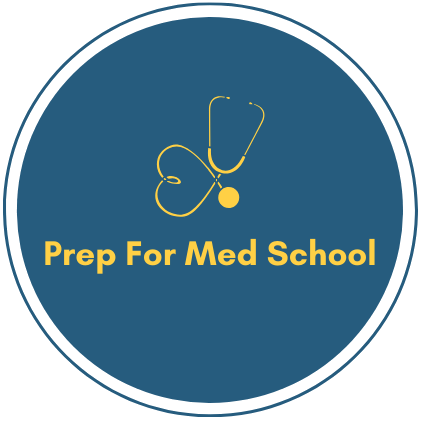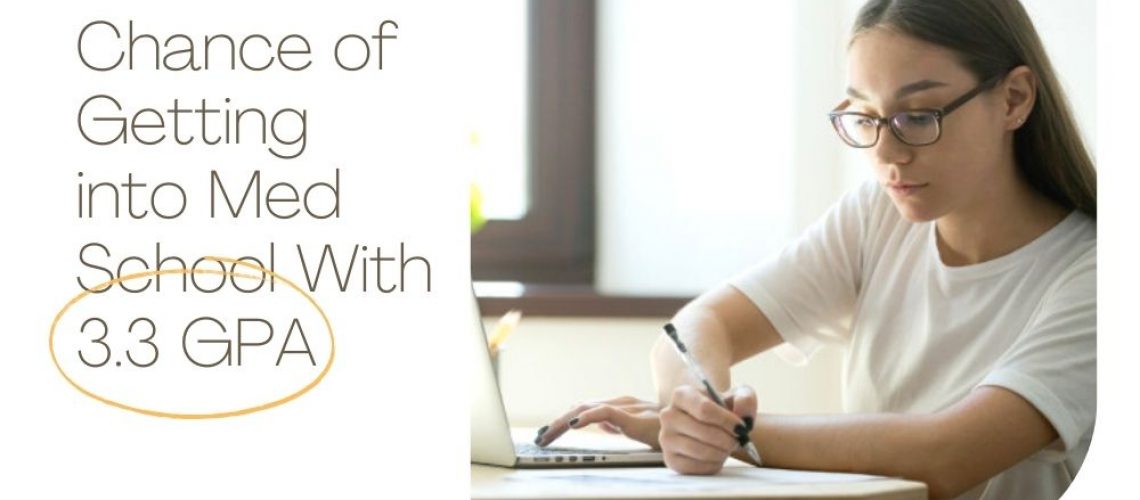In short, you have an okay shot at getting into medical school (according to numbers).
The probability of getting into medical school with a 3.3 GPA is 39.5% to 56.7% depending on your MCAT scores and whether you apply for allopathic or osteopathic schools. Below, we delve into the metrics and explore what you can do to increase your chances.
U.S. News reported that in 2019, the average median GPA was 3.72, and most successful applicants were at 3.4 or higher. The number is even higher for those pursuing MD/Ph.D. programs.
Admission experts suggest maintaining a 3.0 GPA even though most medical schools don’t have a minimum GPA requirement. However, a 3.0 GPA will not get you into most medical schools, especially without a stellar MCAT score.
But of course, don’t let your GPA deter you from applying–many other factors can make you a great candidate!
What The Metrics Say
The overall acceptance rate of all allopathic medical school applicants that had a GPA between 3.20 and 3.39 was 22.1%, which was taken from AAMC numbers from 2017-2018 to 2019-2020.
It is easier to get accepted with a higher MCAT score. With a GPA between 3.00 and 3.19, a 502-505 MCAT score had a 21.8% acceptance rate, 40.3% with a 510 – 513 MCAT score, and 56.7% with an MCAT score greater than 517.
| 3.00-3.19 GPA | MCAT Score | 502-505 | 506-509 | 510-513 | 514-517 | Greater than 517 |
| Acceptance Rate | 21.8% | 29.2% | 40.3% | 49.0% | 56.7% |
In summary, the chances of being accepted into an allopathic medical school hover around 22% to 55% with a 3.3 GPA. For osteopathic schools, the percentage is roughly the same: 39.5% of 2019 admitted applicants had an overall GPA between 3.20 and 3.59. In fact, for DO applicants, the chances of getting accepted with a 3.3 GPA is roughly the same as if you were to have a higher GPA (up to 4.0).
See your chances of getting into medical school with a 3.3 GPA with our LizzyM calculator that matches target schools with your GPA and MCAT.
Being More Competitive with a 3.3 GPA
There are some ways to make your application more competitive with the GPA you currently have.
What About My GPA?
While your GPA is not low, it may not be very competitive. We estimate that your chance of getting in with a 3.1 GPA is anywhere from 15.7% to 54.7%. So with a 3.3 GPA, a 39.5% to 56.7% chance of getting in is a much closer band on the probability scale.
One thing to note is that your science GPA is more important than your cumulative GPA. With a 3.3 GPA, still make sure your science GPA is as high as possible.
As a college freshman or sophomore, the goal now is to get your GPA as close to a 3.5 as possible. You still have two years ahead of you AND all your science classes. Work on studying more effectively. Doing so will help you ace the harder science classes–a double win. In the long run, you can raise your science GPA, build an upward trajectory, and show tenacity!
If you failed a prerequisite class (D or F), consider retaking the class if you have time. This will show admissions that you are up for a challenge, and also help bring your GPA up. If you have a C, your time might be better spent buffing up other areas of your application. Otherwise, taking a gap year or two can be beneficial as well! Read on to see what you can do.
What Can I Do For A Competitive Med School App?
If you think your GPA isn’t enough, a gap year or two might just spruce up your application. Good news: the median age of students entering med school is twenty-four, which means many people take some time off after college before applying. A gap year can be used to gain experience or take graduate-level science courses to boost your GPA.
A popular gap year activity is scribing (or roles in a clinical setting) because of all the medical-related experience you may gain during your time there. Nothing is better than hands-on experience, and this is all while getting paid!
Can I do something that’s not strictly medicine?
Yes! Go join a startup or pursue music for a bit. What you get at the end of any experience will still be valuable. Medical schools also care about activities that can demonstrate key physician skills like empathy, communication, and teamwork.
In the meantime, make sure you have all the other requirements for applying to med school!
Should I Still Apply?
An offer from an osteopathic school has a much chance as an offer from an allopathic school (15.7% vs 16.9% respectively).
Data doesn’t lie. Students are still getting in with a GPA of 3.3…so not all hope is lost! Admission committees look at applications holistically, so bolster the other parts.
- Focus On Doing Great On The MCAT
Medical schools will want students with high MCAT scores as it is the first indicator of your academic prowess. When MCAT scores are above 517 from around 500, the acceptance rate shoots up to 56.7% from 21.8%, according to recent data.
The MCAT is but the first of a series of exams you’ll encounter through your medical training. Thus, show schools that you can handle any academic hurdle they throw at you with a bomb-tastic MCAT score.
- Show That You Are More Than Your GPA
Other sections of the medical school application include research experience, extracurricular activities, clinical experience, letters of recommendation, and other stuff (e.g. honors and awards).
Remember, the goal of the application is to get an interview invite. Use it to highlight characteristics that make you a good fit in the student community and the healthcare workforce.
- Think About What You Can Say About Your GPA
A 3.3 is not bad, and you might not be asked about it. However, make sure you can talk about any significant drops in your transcript in case they do ask. Keep in mind: getting an interview invite means they like you already–so now is your time to explain yourself if needed.
Always talk about your failures with confidence and always share how you learned from them. It shows your maturity and proper level of thinking when handling difficult situations, which is necessary for this line of work.
- Rank Your School List Realistically
Be realistic when deciding where to apply to. Research and use tools like the AAMC MSAR to help you stratify what schools are “far reaches,” “reaches,” or “targets.” While some schools have no or low minimum GPA requirements, their incoming student profiles will show you what they look for.
In fact, use matriculant data to evaluate your chances. Think about other factors that may help you. For instance, in-state schools generally prefer to take in-state residents. If you need help, make sure to reach out to your pre-med advisor to tailor a school list.
At the end of the day, no matter which school you get into, you will have a degree and license to practice. You are still a doctor. That’s all that matters.
- Consider Applying To A Caribbean School
Lastly, you could apply to a Caribbean school to widen your choices.
Graduates of Caribbean medical schools generally have a significantly lower residency match rate than graduates of DO/MD programs based in the United States. According to the 2020 NRMP Match Results and Data, residency match rates were roughly 30% lower for international medical graduates (IMGs).
Do plenty of research and weigh your options before deciding!

The Final Thought
A 3.3 GPA will not sink your med school dreams but it may make it a bit harder. The best thing to do, according to accepted student data, is to have a high MCAT score. Besides grades, your extracurriculars will definitely help you gain an edge.
To become a good physician, you need more than just brains and good grades. It takes high spirits and a positive attitude to get through this long journey, full of ups and downs. So don’t give up and you’ll get there!
What other questions do you have? What advice might you share with fellow pre-meds? Feel free to share and comment if so. Let us know what you think.







